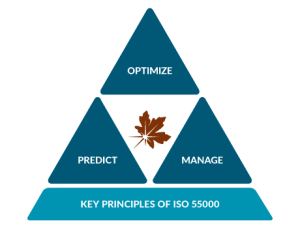Success Requires Doing the Right Projects, Not Just Doing Projects Right
In any discussion about asset management these days, the ISO 55000 standard is bound to come up. ISO published the standard in 2014 to provide guidance on best-in-class asset management practices and help organizations “realize the maximum value from their assets”. In a nutshell, it’s about choosing the ‘right’ things to invest in—the projects that will deliver the highest value, and are most aligned with your company’s strategy.
It’s also about creating a plan—a roadmap for success—laying out what will be done, when, by whom and how it will be evaluated. The plan must address how to keep assets operating at their optimal level of performance, while managing risk, and respecting the available budgets and resources.
Sounds simple but this is no easy task, especially in organizations with tens of thousands, or even millions of diverse assets.
A goal without a plan is just a wish.
Antoine de Saint Exupéry
Asset Investment Planning and Management (AIPM) is an evolving discipline that helps organizations focus their available resources on doing the right things at the right time. AIPM can help you:
- PREDICT the long-term needs of your asset base
- OPTIMIZE portfolios of investments to realize the greatest value from your assets
- MANAGE your portfolios to achieve the highest execution performance

When these three principles of AIPM are put in place, organizations can start to make these complex investment decisions with confidence.
PREDICT: Asset managers must focus on predicting the needs of their corporation’s assets, and on developing a realizable investment strategy to meet those needs. The key word here is realizable. It’s not just about identifying the ideal thing to do for every asset, because you invariably won’t be able to afford to do every “ideal” thing you are asked to. You need to propose a strategy that you can afford, and have adequate resources to carry out. This is where the second part of the strategy comes in.
OPTIMIZE: If your investment requests exceed your available budget and/or resources, you need to develop a plan that delivers the most value for the money and resources you do have. In a previous post I talked about Value-based Decision Making. This is where that really comes in handy. When you can’t do it all, you need to consider deferring some investments and/or evaluate alternative ways to address the needs identified above. Value-based decision making can help you make the difficult trade-offs between risk, cost, and performance, and ensure that for your available funding and resources, you are always executing a plan that delivers the maximum value from your assets.
MANAGE: Even the best plans never execute as expected. Emergent work, delays, and cost overruns all affect your organization’s ability to deliver on the original set of objectives. Actual spend and accomplishments should be compared to the original plan, variances explored, and the plan re-optimized to ensure that looking forward, the organization is always focused on those activities that deliver the highest value. This process of continuous planning is an integral part of a best-in-class asset investment strategy.
AIPM can help you make higher value investment decisions, and justify those decisions to stakeholders. To learn more about how AIPM supports the ISO 55000 standard, download this white paper.

